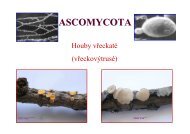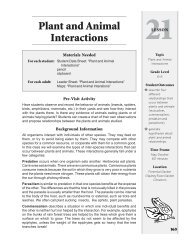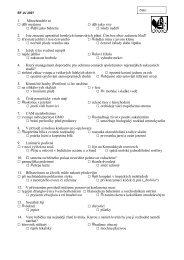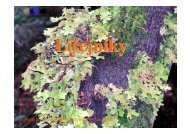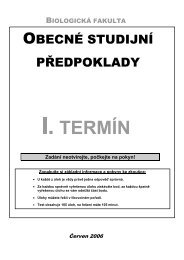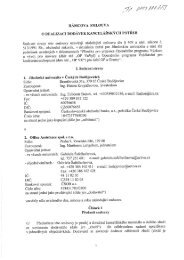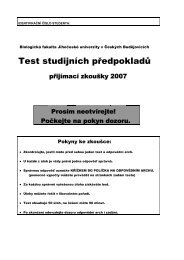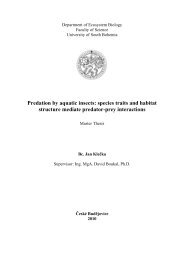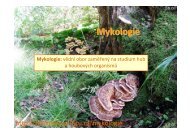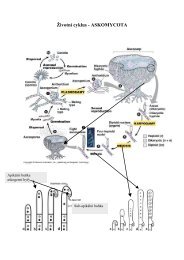The structure and dynamics of a water beetle community in a ...
The structure and dynamics of a water beetle community in a ...
The structure and dynamics of a water beetle community in a ...
You also want an ePaper? Increase the reach of your titles
YUMPU automatically turns print PDFs into web optimized ePapers that Google loves.
4.1 Review <strong>of</strong> the literature – Spatiotemporal <strong>dynamics</strong>, habitat associations, biotic <strong>and</strong><br />
abiotic factors shap<strong>in</strong>g <strong>water</strong> <strong>in</strong>sect communities <strong>of</strong> stagnant <strong>water</strong>s<br />
Habitat associations<br />
Various abiotic <strong>and</strong> biotic factors are known to <strong>in</strong>fluence the composition <strong>of</strong> <strong>in</strong>sect<br />
communities <strong>in</strong> stagnant <strong>water</strong> bodies. <strong>The</strong> current knowledge is taxonomically highly biased<br />
towards dragonflies <strong>and</strong> damselflies (Odonata) but it seems that the <strong>structure</strong> <strong>of</strong> communities<br />
is shaped by a wide range <strong>of</strong> both abiotic <strong>and</strong> biotic factors, the dom<strong>in</strong>ant ones generally<br />
be<strong>in</strong>g habitat permanence <strong>and</strong> predation (Wellborn et al. 1996; Entrek<strong>in</strong> et al. 2001; McPeek<br />
1990, 2003a, 2003b). <strong>The</strong> species composition changes <strong>and</strong> the diversity generally <strong>in</strong>creases<br />
along successional gradients (Fairchild et al. 2000, Suh & Samways 2005). This may be<br />
caused by the <strong>in</strong>crease <strong>of</strong> amount <strong>of</strong> vegetation, <strong>in</strong>vasion by predators, <strong>and</strong> other consequent<br />
changes. In the follow<strong>in</strong>g text, I briefly discuss the importance <strong>of</strong> physicochemical variables,<br />
habitat permanence, submerged vegetation, presence <strong>of</strong> fish predators, <strong>and</strong> <strong>in</strong>teractions<br />
between <strong>in</strong>vertebrate predators.<br />
Abiotic factors<br />
Abiotic factors such as hydrology <strong>and</strong> <strong>water</strong> chemistry have been long considered as<br />
important determ<strong>in</strong>ants <strong>of</strong> the composition <strong>of</strong> <strong>water</strong> <strong>in</strong>sect communities. More recent <strong>in</strong>sights<br />
highlight the importance <strong>of</strong> <strong>in</strong>terspecific <strong>in</strong>teractions on structur<strong>in</strong>g communities (e.g.<br />
McPeek 1990; see below), while the significance <strong>of</strong> <strong>in</strong>dividual variables <strong>of</strong> <strong>water</strong> chemistry is<br />
be<strong>in</strong>g disputed. From physico-chemical variables proposed to affect aquatic animals through<br />
their impact on physiology, pH is <strong>of</strong>ten considered as an important factor determ<strong>in</strong><strong>in</strong>g the<br />
composition <strong>of</strong> <strong>water</strong> <strong>in</strong>sect communities (e.g. Bendell & McNicol 1995; Johansson &<br />
Brod<strong>in</strong> 2003; Nicolet et al. 2004) but recent results demonstrate that at least some species <strong>of</strong><br />
<strong>water</strong> <strong>in</strong>sects have a high tolerance for low pH. Wollmann (2000) collected several species <strong>of</strong><br />
the Corixidae <strong>in</strong> lakes with pH



